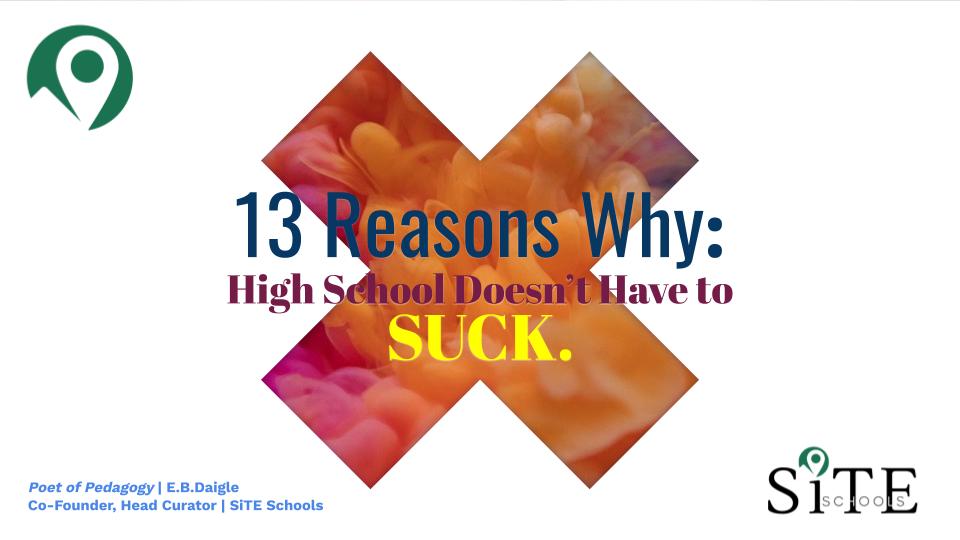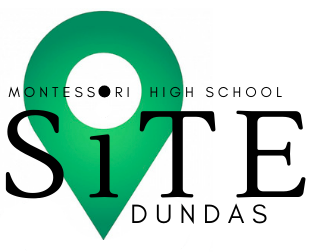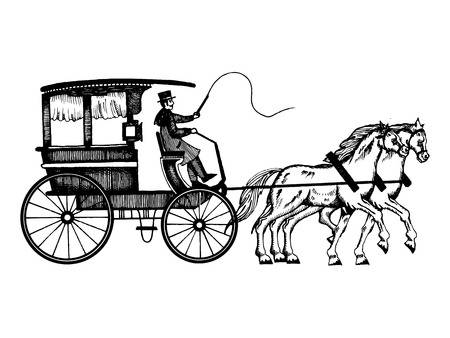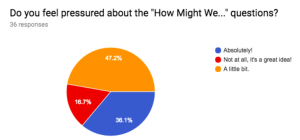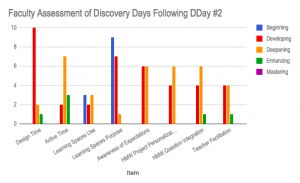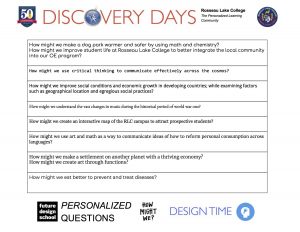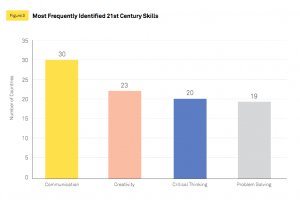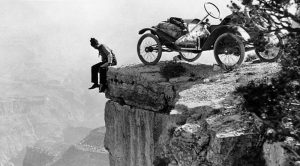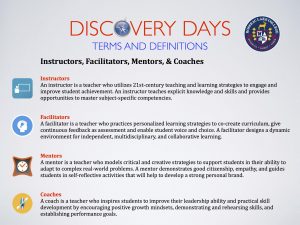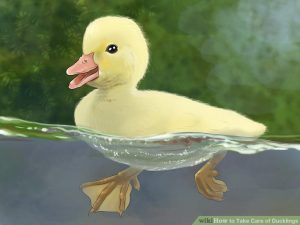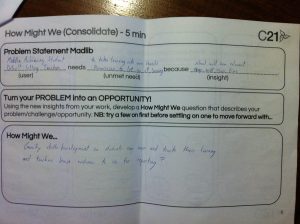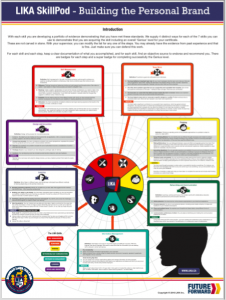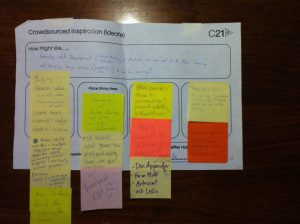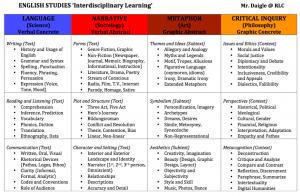Starting tomorrow there are 13 days until our next Cohort21 F2F. I will be submitting a separate slide each day to help get you pumped for the How Might We... possibilities of changing education in 2020. Enjoy!
Tag Archives: pedagogy
How Might We Start a School?
For those of you unfamiliar with the brainstorming and iterative process known as Design Thinking, one of its most beneficial takeaways comes in the formation of what is called a HOW MIGHT WE question. This simple but profoundly empathetic injunction really gets the creative juices flowing; it can help to organize an action plan, kickstart an entrepreneurial endeavour, or overhaul a stale vision, allowing everyone involved—from the financial team to the end product user—to imagine new possibilities in solving tough challenges and addressing needs. What started as an esoteric creative process amongst designers and engineers, eventually made its way to Stanford University education research and into the popular imagination. Shows like Netflix’s ABSTRACT, showcase the influential power design has as an integrative discipline, continuously pushing the boundaries between art and science, psychology and business, math and philosophy.
What we’ve found is that kids are especially good at following the critical and creative stages of a Design Thinking process (it mirrors their natural curiosity and hands-on experimenting instinct); perhaps why the Design Thinking mindset has particularly benefitted inquiry-based approaches, PBL, Makerspace, and STEM or STEAM prototyping programs in school systems around the world.
For educators, Design Thinking is an especially powerful tool for professional development (Cohort21 spends the bulk of its workshop facilitation on an action plan based around this process) because our world has changed so rapidly in the past few decades, the importance of innovation in education has risen to become a top priority in both public and private systems. Simply put, schools can’t afford to disengage the next generation of students into what should be their human right: a profound sense of discovery through the power of learning. We know this personalized discovery process is no longer served by traditional factory models, over-stuffed classrooms, and out-dated academic achievement-only environments. It is up to every single teacher, administrator, and education system to recognize the various disconnects in their models and redesign unique and sustainable ways to improve. Innovate or die, as the saying goes.
A HOW MIGHT WE question has at its root, all the ingredients needed to establish an environment of inventiveness and openness. The question HOW is a practical extension of WHY and forces the dreamer into more utilitarian ways of problem solving, through constraint. The MIGHT ensures this is an iterative process, of countless prototyping and drafts, of formative experimentation that, yes, may indeed lead to failure (or new ways of looking at the same old!). There is resilience in MIGHT, adaptability in MIGHT, but also a positive desire and hope for change. Finally, there is the necessary WE. Collaboration and diverse perspectives are key to any successful venture. Empathizing with your end user ensures an ability to radically alter, if need be, the purpose and outcome of the change itself. If an idea is sometimes referred to as a “baby”, than it truly takes a village to innovate one.
Which brings me to my current challenge. I’ve co-founded a school named SiTE (Situated in Transformative Environments): a Montessori high school in Dundas, Ontario. Thankfully, my co-founder, Tony Evans, 18 years ago established an unbelievable community of progressive parents and self-directed children through his two other high-fidelity Montessori schools, Dundas Valley Montessori School, and Strata Montessori Adolescent School. Why Dundas? Here is one reason:
As with any new venture that is already up and running (10 courageous students started learning with me on September 3), we don’t have the luxury of prolonged research and development phase—we are iterating on the fly! At a recent international adolescent Montessori workshop (AMI/NAMTA) I attended in North Carolina, I was reminded just how bold an endeavour SiTE Schools is when out of a group of 100 Montessori educators, only one other school had extended their program to encompass Grade 10, 11, and 12 (Academy of Thought & Industry). In fact, when I researched Canadian Montessori high schools in the Our Kids website, I found only a half-dozen schools even attempting to tackle the senior secondary years in an authentic Montessori-style, and all of them are operating from an actual building! Have I got your attention yet?
Here is a highlight reel of the many many HOW MIGHT WE questions I’m wrestling with as I venture upon the greatest challenge of my professional career:
- How might we create an adolescent Montessori micro-school without a traditional bricks & mortar building?
- How might we use our unique small-town environment as flexible learning spaces that enhance subject mastery?
- How might we partner with local business, galleries, Universities, to co-create real-world projects?
- How might we reimagine the idea of teenagers and community for the 21st century?
- How might we create a flexible timetable that starts at 10:00 and revolves around opportunities for outdoor and experiential learning?
- How might we create a “quest-like” block course calendar where students immerse themselves in single subject areas for a concentrated period of time?
- How might the daily timetable be self-directed?
- How might we create a school of experience instead of a school of compliance?
- How might we bring dignity to adolescence?
- How might we enhance student initiative through purposeful work and meaningful context?
- How might we track students or take attendance when the entire community is your campus?
- How might we establish a tuition that is equitable and competitive?
- How might we teach all three senior levels (Gr 10, 11, 12) at the same time?
- How might we have one teacher to curate all subject material and use a team of experts to facilitate skill-building?
- How might we turn every single assignment into either a group or independent inquiry project?
- How might we create a “living curriculum” based on the personal interests of each student and the changing needs of the community?
- How might we co-construct curriculum with students and still achieve ministry expectations?
- How might we use socratic seminar (discussion and debate) for every lesson?
- How might we use ONE single-point rubric to assess ALL assignments within a course?
- How might we use an ongoing standards-based gradeless assessment?
- How might we becomes guides instead of teachers, curators instead of facilitators, advisors instead of mentors?
- How might we market the school with full parent/student participation?
If any of these questions relate to areas of interest you are currently considering developing in your school, let’s talk. Please consider your sphere of influence (Garth will talk about this at our 2nd F2F). I am grateful to be tackling the teaching opportunity of a lifetime and am ready and willing to be the guinea pig for all manner of educational innovation and disruption.
But I can’t do it alone. Nor do I need to.
Cohort21, developed 8 years ago as a CISOntario incubator for 21st century PD, is a vibrant community of innovative educators who have greatly helped me these past four years develop into the disruptor I feel I was destined to be. @gnichols has mentored me through some profound life changes, guiding me towards embracing the positive inventiveness he demonstrates daily at Havergal College. @jmedved is a beacon of innovation, always rethinking the HOW from his York School perch. @ckirsh has pushed me to question ethical choices and even challenged my MIGHT to join her podcast. @gvogt is my doppelgänger, a fellow poet of pedagogy in a sea of disruptive potential. No other person could have helped steward the Discovery Day initiative at Rosseau Lake College, making it even more engaging and sustainable. @lmcbeth is the queen of Design Thinking and through her work with the Future Design School has greatly shaped how I view education and entrepreneurship. @lbettencourt and @adamcaplan will trial anything tech in the most transparent of ways, sharing as they fail forward. @nblair is my spirit guide when it comes to questioning the status quo—no one does it better or with more grace.
There are more. Too many to mention here. Past facilitators, current coaches, former colleagues, and alumni galore. Cohort21 has a treasure trove of action plans at your disposal to pillage and plunder as you formulate your own powerful HOW MIGHT WE. Make sure to steal like an artist.
Folks, this is your village, this is your WE.
Education is Like the Car
One of the most common criticisms we hear from teachers is usually voiced at the time they are being confronted with yet another change to their teaching and learning practice. This is the critique that any new initiative, edtech or life skills or otherwise, is really just the same old idea coming around again, repackaged with 21st-century buzzwords. Especially if you’ve been teaching for some time or work in a school that is culturally risk averse, there is a certain sense of deja-vu with most pedagogical “innovations”. Been there, done that, never getting that weekend back! Anyone remember Wikis or Zines? Constant provincial ministry mandates and ongoing administrator classroom strategies don’t seem to help abate this trend towards the cynical.
The frustration is real. It’s the metaphor that lacks.
I’ve found an easier way to view innovation in education. Through the allegory of the car. Yes, not much has changed since the discovery that four wheels can get us places faster. The horse drawn carriage was replaced by the internal combustion engine. Henry Ford’s Model T ushered the motor vehicle into the age of mass production. Tesla now has record sales for the electric car. Still just four wheels. Isn’t it just the same thing over and over again, repackaged?
If, however, you pause to consider how many small yet crucial design elements have added to and improved this basic human transport need; from removing coachmen and allowing passengers to drive themselves, to safety measures such as the seatbelt and airbags, environmental pushes towards cleaner exhaust, greater mileage, winter tires, internal navigation systems, and now, automated self-driving vehicles.
The factory model of education may still be the most efficient way to instruct large populations of students, but education has come a long way since the single room school house. How we design and run these “factories” makes all the difference to how we see and conduct ourselves as teachers and the experience of open mindedness and curiosity we model for each student. Every educational theory and teaching trend, from Dewey to Vygotsky, from Montessori to Gardner, from Fullan to Hattie, Duckworth to Cain, all of them add incremental yet vital elements to our dynamic pedagogical toolbox, as well as providing fundamental progress to this noble profession.
So hold your head high at the next staff meeting. Avoid the temptation to slide into your default setting. Think of how YouTube is really just like the seat warmer in your car.
Like Spinning Plates
As an English teacher I’m always looking for the apt metaphor, that one-of-a-kind allegory which will once and for all, 100% no-questions-asked-put-your-hands-down-please definitively define what it is we do, day-in and day-out, as 21st century educators. I believe this one comes close.
The reasons why I like the visual synecdoche of the plate spinner may surprise you. In my heart, I know this is the healthiest model to explain why teachers need to give themselves a break, before they break themselves. And more often than you might think.
In talking with a colleague recently, the age-old adage of teachers not having enough TIME reared its perennial head. If it’s not TIME than it’s surely RESOURCES; (un-PC trigger warning alert!) the two twin towers of educational stress and anxiety.
But if we simply re-framed what we do as already impossible, perhaps then (only then) glimpses of the possible and profound would peek through. If politics is the art of the possible, then teaching is the impossible art!
If we divide teaching and learning into four ready-made components, they might be:
- Curriculum Design
- Instruction
- Assessment & Evaluation
- Reporting
If you think of these as the 4 plates we are constantly spinning, then you would be forgiven for thinking teachers have it easy, perhaps even under control. But, we know, like all good magic tricks, control is an illusion. The reality is there are spinning plates underneath these 4 plates, and more spinning plates under those– turtles on top of turtles, all the way to spinning infinity (R.I.P. Stephen Hawking).
The secret thus becomes this: in order to survive the greatest show on earth that is our noble profession, we can only spin ONE PLATE AT A TIME!!!
Yep. That’s it. Sarcastically sublime. Not as memorable as “with great power comes great responsibility” (R.I.P. Stan Lee), but nonetheless, reflective respite.
In other words, if you are concentrating on updating or improving strategies with your Instructional practice this year, you can let your other plates wobble for a little while. If- as I am doing this year- you find yourself with an opportunity and willing department, to radically change how you approach Assessment & Evaluation, than your Reporting might just not produce those wonderful bon mots you have so carefully curated and copy-and-pasted in previous times.
We set our own priorities, then we define personal best practice by them. If we don’t measure up to this exponential diagnostic quagmire, we imagine our plates have smashed and we have failed. We also unfairly project this best practice onto our colleagues and schools and when we do this we are guaranteed to find discrepancy- you see, we are all spinning different plates! This discrepancy may lead to stress and anxiety if used as performance comparison, especially as school mandates and department initiatives pile up, distracting you from your default-setting favourite plate; you know, the one you have the most control over so you spend all of your time spinning because if anyone noticed that your other plates were not spinning (or, gulp, missing) they might not see you as that grand wizard teacher anymore.
What we need to remind ourselves of, when everything is spinning, we can only control that which tasks our immediate concern or is in our sphere of influence. From there we can decide which plate to spin next, which one deserves the most attention, AND, most importantly when it comes to innovation and cultivating a growth mindset, which one we haven’t spun in a while.
Who are the expert spinners I look up to? @gnichols, @jmedved, @lmcbeth, @adamcaplan, @nblair, @gvogt, @ckirsh, @lbettencourt, @ddoucet, @timrollwagen, @amacrae, @lmustard, @amaingot, @lfarooq, @dmonson, @shelleythomas, @vboomgaardt, @tfaucher, @lmitchell, @mmoore, @ljensen, @mneale, @egelleny
Wow, that’s a lot of sturdy plates!
UPDATE
Here is a handy graphic to help you prioritize. Turns out it was invented by former U.S. President, Dwight D. Eisenhower!
One-Stop-Shop for Innovation Research
Rosseau Lake College’s inquiry-based and experiential learning initiative, DISCOVERY DAYS, like all truly great things, rests on the shoulders of giants. I was inspired by the following schools and articles and perhaps you might be too.
DESIGN TIME RESEARCH (Inquiry-Based Learning)
JOURNAL/ BLOG |
LINK |
SUMMARY QUOTES |
| Professionally Speaking | Self-Directed Learning | In other words, explains principal Patricia Coburn, OCT, students set their own learning goals, follow a personalized program and work and learn in an environment that enables them to actively pursue self-directed learning. |
| Flow Blog | Self-Directed Learning & Exam Scores | Students’ success on the IB DP exams became the measure against which SDL time was evaluated. In that very first year of SDL time students’ DP exam averages exceeded the results of all previous years. |
| Getting Smart | Integrated Curriculum | Repko (2009) and others have asserted that interdisciplinary instruction fosters advances in cognitive ability and gains in the ability to recognize bias, think critically, tolerate ambiguity, acknowledge and appreciate ethical concerns. |
| Carleton College | Interdisciplinary Learning | Engaging students and helping them to develop knowledge, insights, problem solving skills, self-confidence, self-efficacy, and a passion for learning are common goals that educators bring to the classroom, and interdisciplinary instruction and exploration promotes realization of these objectives. |
| Corwin Connect | PBL & Direct Instruction | My argument here is that if we utilize effective direct instruction in the PBL/PrBL classroom specifically in situations where students are building knowledge and skill then we may substantially mitigate the limiting effect of the method as it relates to learning. |
List of Schools Adopting Similar DESIGN TIME Initiatives:
Canadian Coalition of Self-Directed Learning
Mary Ward Catholic Secondary School in Toronto has been pioneering student-directed learning for the past 20 years.
SEED, in Toronto, is North America’s oldest public alternative school specializing in self-directed learning.
High Tech High (U.S.)*
The exemplar of Project-Based Learning in action, this innovative school in San Diego was featured in Tony Wagner’s book and subsequent documentary film, Most Likely to Succeed.
Lindsay Unified Public Schools (U.S)*
The district personalizes learning by giving students a performance-based model that lets students progress after they demonstrate mastery. School days are split between self-directed learning and teacher-led instruction. District teachers are called “learning facilitators,” and even during teacher-led instruction, students can choose from various assignments and learning experiences.
Taylor County School District (U.S.)*
District leaders realized that “one size fits all” doesn’t work when it comes to student learning. Now, teachers and students work together to create individualized learning plans based on students’ needs, interests and goals. The approach includes project-based learning, self-based learning, online learning, and peer-led instruction.
JFK Eagle Academy (U.S.)*
The school developed a program focused on Socratic seminars and leadership development, because teachers and school leaders believe students benefit from inquiry, critical thinking and problem-solving. Students work at their own pace toward college and career readiness.
LINC High School (U.S.)*
School administrators believe every student can be a leader, and student agency, leadership and character education is an important part of the school’s philosophy. Classes aren’t organized into traditional subjects, but instead are grouped into 30-day “learning modules” that integrate various subjects and let students explore local, national and international issues through research and critical thinking.
The Putney School (U.S.)
“Our semi-annual Project Weeks challenge students to dive deep into something they have learned in their academic coursework, make it personal, and mobilize it creatively. While we focus on research and process, the results are incredible… Project Weeks are all about mobilizing knowledge: connecting disciplines, digging through deeper ideas, and applying what one has learned.”
*https://www.eschoolnews.com/2017/02/16/personalized-learning-action/2/?all
FLEX TIME RESEARCH (Skills-Based Learning)
JOURNAL/ BLOG |
LINK |
SUMMARY QUOTES |
| 20Time.org | Passion Projects | 20Time projects allow students to track their learning growth, which supercharges intrinsic motivation. Way more effective than grades and other carrots and sticks. |
| Genius Hour Journal | Genius Hour | The search-engine giant, Google, allows its engineers to spend 20% of their time to work on any pet project that they want. The idea is very simple. Allow people to work on something that interests them, and productivity will go up. |
| 20 Time in Education Blog | 20% Time | Daniel Pink asks what drives us. Sir Ken Robinson asks us to inspire creativity in our students. The latest in education is asking us to teach our students to create their own questions, do their own research, and form their own conclusions with their learning. Why? The world is a collaborative, communicative place and it is the world of online tools that has made it this way. Our students’ workplaces will be places with teams at tables, not individuals in cubicles. They will be asked to be innovative and create the next tool, not to push bureaucratic paper. We must teach them how to think on their own without being told what to do. We need to teach them to be autonomous learners. Only one who can guide his own learning can effectively contribute to a team. |
| ASCD | The Genius of Design | Despite its exciting beginning, that first Genius Hour project more than 10 years ago actually failed on many levels. I provided too much structure in areas where students needed more freedom and agency. I didn’t provide enough scaffolding in areas where they lacked necessary skills. I failed to anticipate some of the social and emotional challenges of giving students the freedom to learn what they wanted to learn.
Still, even with all of these mistakes, something was different. My students were empowered to take their learning in their own direction. |
| Ontario Ministry of Education | 21st Century Competencies | Researchers acknowledge that the need to engage in problem-solving and critical and creative thinking has “always been at the core of learning and innovation” (Trilling & Fadel, 2009, p. 50). What’s new in the 21st century is the call for education systems to emphasize and develop these competencies in explicit and intentional ways through deliberate changes in curriculum design and pedagogical practice. The goal of these changes is to prepare students to solve messy, complex problems – including problems we don’t yet know about – associated with living in a competitive, globally connected, and technologically intensive world. |
| Brookings | Skills Movement Across Education | Around the world education systems are increasingly inclusive of a broad range of skills in curricula to prepare students for the complex challenges of this century. |
| World Economic Forum | Future Job Skills | Five years from now, over one-third of skills (35%) that are considered important in today’s workforce will have changed. |
| World Economic Forum | Jobs are Changing | What is clear is that interpersonal skills are unlikely to be rendered obsolete by technological innovation or economic disruptions. In a changing workforce, it’s having a strong foundation in these versatile, cross-functional skills that allows people to successfully pivot. |
| Quartz | What Skills do Kids Need to Thrive | New research from the Sutton Trust, a British foundation focused on social mobility, finds that 88% of young people, 94% of employers, and 97% of teachers say these so-called life skills are as or more important than academic qualifications. |
List of Schools Adopting Similar FLEX TIME Initiatives:
Rothesay Netherwood – New Brunswick (Genius Hour & Disrupted)
The only independent school in New Brunswick, Rothesay has adopted numerous innovations to give their students voice-and-choice over passions and interests. Most recently they have empathized with students by creating assessment blocks in which only specific subject areas are able to administer summative assessment one at a time. This aims to help students and teachers work smarter at not overwhelming and overstuffing the learning.
The York School – Toronto (Genius Hour)
A pioneer in technology integration, this Toronto independent school has paved the way for diverse Passion Projects across grade levels.
Holy Trinity School – Richmond Hill, Toronto (Flex Time)
This middle and senior school initiative gives students weekly choice over which activities or tutorials will best help them succeed.
Hillfield Strathallan College – Hamilton (Flex Time)
A wide-reaching whole-school initiative in which one hour per day is organized around student academic needs, well-being activities, and PBL guidance. Students choose where they should be and what they should learn.
ACTIVE TIME RESEARCH (Experiential Learning)
JOURNAL/ BLOG |
LINK |
SUMMARY QUOTES |
| Getting Smart | Social Emotional Learning Research | The statement that “Social, emotional, and cognitive competencies can be taught and developed throughout childhood, adolescence, and beyond,” certainly underscores Carol Dweck’s work around growth mindset. In short, we aren’t simply born with or without SEL traits; rather, they can be taught and shaped throughout our experiences. |
| Global Digital Citizen Foundation | 5 Ways Outdoor Education Can Prepare our Students for the Future | Outdoor Education can be widely defined, but generally is a form of experiential organised learning that occurs in an outdoor setting and typically involves “journey-based experiences in which students participate in a variety of adventurous, memorable challenges.” This style of learning has various benefits, from cultivating the relevant emotional intelligence needed for effective leadership, to develop the confidence and competence needed to persevere in stressful situations. |
List of Schools Adopting Similar ACTIVE TIME Initiatives:
Havergal College (Day 9 Initiative)
The mission for Day 9 is to align the school’s values and mission through curated, co-created experiences with faculty and students. Day 9s are opportunities to deepen and extend learning.
University and College Information
JOURNAL/ BLOG |
LINK |
SUMMARY QUOTES |
| Stanford Social Innovation Review | Education is Changing | There is therefore no doubt about where education is going, but there is a great deal of uncertainty concerning how to get there, and, importantly, how to measure progress along the way. |
| Harvard Graduate School (College Admissions) | Turning the Tide | … high school students often perceive colleges as simply valuing their achievements, not their responsibility for others and their communities. |
| TES | Independent School Pupils Feel More Prepared for University | One of the suggestions for students is reminding themselves what “independent learning” means to ensure they are prepared for an environment where there is less direct hands-on teaching support. |
| NAIS | Mastery Transcript Consortium | In other words, many students do not learn about the world in school; instead, they learn about a teacher’s preferences, a test’s likeliest questions, and their own ability or inability to master a system that doesn’t place their growth first. |
| Innovative Post-Secondary Institutions | Minerva Schools | Minerva focuses on developing your abilities to think critically and creatively, to communicate effectively, and to work well with others. These aspects of your education are far more important than simply memorizing facts and concepts because they provide a set of practical and adaptable skills, together with an understanding of how to apply them in the world. |
| Innovative Post-Secondary Institutions | Quest University Canada | Each student is required to take between one and four experiential blocks as part of his or her academic program. These blocks are designed to meet each student’s academic and career interests and can include varied experiences, |
LIST OF FURTHER RESOURCES
Alexander, C & McKean, M. (2017, October 22). The Problem of Youth Unemployment: Predicting the Changing Future of Work. Globe & Mail. Retrieved from https://beta.theglobeandmail.com/report-on-business/rob-commentary/the-problem-of-youth-unemployment-predicting-the-changing-future-of-work/article
Berger, R. (2017, October 25). The Importance of Academic Courage. Edutopia. Retrieved from https://www.edutopia.org/article/importance-academic-courage?utm_source=twitter&utm_medium=socialflow
Buck Institute for Education (2017). What is Project Based Learning (PBL)? Retrieved from https://www.bie.org/about/what_pbl
Engelbert, C. & Hagel, J. (2017, July 31) Radically open: Tom Friedman on jobs, learning, and the future of work. Deloitte Review (21) Retrieved from journal https://dupress.deloitte.com/dup-us-en/deloitte-review/issue-21/tom-friedman-interview-jobs-learning-future-of-work.html?id=dup-us-en:2sm:3tw:4dup_gl:5eng:6dup
Fullan, M. (2014, January). A Rich Seam: How New Pedagogies Find Deep Learning. Retrieved from http://www.michaelfullan.ca/wp-content/uploads/2014/01/3897.Rich_Seam_web.pdf
Furedi, F. (2016, June 26). Schools Need to Encourage Students out of their Comfort Zone so they can Adapt to University. TES. Retrieved from https://www.tes.com/news/school-news/breaking-views/schools-need-encourage-students-out-their-comfort-zone-so-they-can
Hoover, E. (2017, November 1) What Colleges Want in an Applicant (Everything). New York Times. Retrieved from https://www.nytimes.com/2017/11/01/education/edlife/what-college-admissions-wants.html
Ontario Ministry of Education. (2016, Fall). 21st Century Competencies: Foundation Document for Discussion. Retrieved from http://www.edugains.ca/resources21CL/About21stCentury/21CL_21stCenturyCompetencies.pdf
Prevette, S. (2017, May). Creating Future Designers: It Starts in the Classroom. Policy Magazine. Retrieved from http://policymagazine.ca/pdf/26/PolicyMagazineMayJune-2017-Prevette.pdf
Kaechele, M. (2017, February 2). Scaffolding the PBL Shift. [Web log post] Retrieved from http://www.bie.org/blog/scaffolding_the_pbl_shift
Lacavera, A. (2017, October 26). We Need to Stop Coddling our Kids if we want Canada to Become a Nation of Entrepreneurs. Globe & Mail. Retrieved from https://beta.theglobeandmail.com/report-on-business/small-business/sb-growth/we-need-to-stop-coddling-our-kids-if-we-want-canada-to-become-a-nation-of-entrepreneurs/article
Lichtman, G. (2014) #EdJourney: A Roadmap to the Future of Education. New Jersey: Jossey-Bass.
Repko, A. (2009). Assessing Interdisciplinary Learning Outcomes. Retrieved from https://oakland.edu/Assets/upload/docs/AIS/Assessing_Interdisiplinary_Learning_Outcomes_(Allen_F._Repko).pdf
Schafer, D. & Yamasaki, K. (2017). Designing Creative Collaboration School Spaces. Building Dialogue. Retrieved from https://crej.com/news/designing-creative-collaboration-school-spaces/
Schneider, J. (2017) What Makes a Great School. Usable Knowledge. [Web log post] Retrieved from https://www.gse.harvard.edu/news/uk/17/10/what-makes-great-school
Swartz, K. (2006, October 4) Why a School’s Master Schedule is a Powerful Enabler of Change. Mind Shift. Retrieved from https://ww2.kqed.org/mindshift/2016/10/24/why-a-schools-master-schedule-is-a-powerful-enabler-of-change/
Terada, Y. (2017, September 20). Why Students Forget – and What You Can Do About It. Edutopia. Retrieved from https://www.edutopia.org/article/why-students-forget-and-what-you-can-do-about-it?utm_source=twitter&utm_medium=socialflow
Tormala, A. (2016, October 24). Discomfort, Growth, and Innovation. Edutopia. Retrieved from https://www.edutopia.org/blog/discomfort-growth-and-innovation-alyssa-tormala
Trilling, B. & Fadel, C. (2009) 21st Century Skills: Learning for Life in Our Times. Jossey-Bass: New Jersey
Wagner, T. & Dintersmith, T. (2015, August 18). Most Likely to Succeed: Preparing Our Kids for the Innovation Era. Scribner. Retrieved from http://www.tonywagner.com/most-likely-to-succeed-preparing-our-kids-for-the-innovation-era/
Walls, J. (2017, November 2). York U Bringing Together New Maker Space in Markham. York University Media Relations. Retrieved from http://news.yorku.ca/2017/11/02/york-u-bringing-together-innovators-and-entrepreneurs-in-new-maker-space-in-markham/?
Wiggins, G. & Mctighe, J. (2011). Understanding by Design: Framework. ASCD. Retrieved from http://www.ascd.org/ASCD/pdf/siteASCD/publications/UbD_WhitePaper0312.pdf
DISCOVERY DAYS: A Work in Progress
PROGRESS REPORT
EARLY FEEDBACK (Day 6 of 12)
The initial six weeks of Rosseau Lake College’s DISCOVERY DAYS have had a mixed reception amongst a small percentage of students and parents. Early criticism came from our Grade 12 class who felt this type of “experimental” learning would interrupt their academic goals of achieving high marks for post-secondary applications. They initially preferred the old system of teacher-developed ISU’s (Independent Study Units) or CT’s (Culminating Tasks) delivered in the last two weeks of a course. DISCOVERY DAYS’ longer timelines gave some students increased stress.
Much of this student-created survey can be interpreted as resistance to change and aversion to risk, especially with those students who have succeeded at the “game of school”. Now that the rules are changing, the development of new skills in previously untested areas is uncomfortable.
A small percentage of dissension has come from traditional analytical learners who feel classroom instruction has been diminished and therefore their opportunities to obtain important information in knowledge-based subjects such as Science and Math compromised.
The academic team sat down with students to listen to their voices and concerns and develop workable solutions. One such solution involved the creation of a “University Preparation” club, for senior students, to run during the Winter Term Active Time block. Facilitated by Math and Science teachers, this period will be used for a multitude of senior academic purposes: individual study, tutorials, catch-up classes, guest lecturers, and post-secondary application workshops.
As well as surveying the students on their level of engagement, we also asked the faculty to assess our progress with individual DISCOVERY DAY initiatives. Again, the results were not surprising given how different and unstructured these days can initially feel. Learning Spaces are still not being recognized or utilized by students as differing to their classroom function. Many students are drawn to spaces because of friendship groups rather than project needs. The Discovery Projects themselves are open-ended and some facilitators find it challenging as to how to help motivate students or link ideas to finished products.
What does success look like?
As quantitative achievement data has yet to be calculated (realistically, we will have to measure this with a longitudinal study over numerous years), we have only anecdotal responses and engagement surveys to gauge initial reception. Active Time has already been received positively by the majority of students who tend to learn in this manner.
For most students, success with Design Time and Flex Time may look something like appreciation of new skills learned and broader knowledge shared. Often times general academic acceptance is retroactive and only given credence after the fact or in the case of individual recognition.
For teachers, success will be in the form of professional development, sharing exciting and innovative ideas around the concept of facilitation.
For me, success already looks like this:
Our entire student body is involved in Project-Based Learning and has developed “How Might We… ?” questions. Added to that, more than half of the students have fully integrated questions that cross most or all of their subject areas.
One definitive measure RLC will be searching for, however, is the quality of the projects themselves. Deep learning experiences should lead to more original and interesting end products. It remains to be seen if the grade-oriented Discovery Projects or the fuelled-by-interests Passion Projects will produce that much-lauded exemplar. In either case, successful projects will be shared and displayed for present and future students of RLC to gain inspiration for continued discoveries.
SUMMARY CONCLUSION
A desire to see what students can do with their hands inspired a recent change at one of the world’s most renowned campuses. Massachusetts Institute of Technology (motto: “Mens et manus,” Latin for “Mind and hand”) now gives applicants the option of submitting a Maker Portfolio to show their “technical creativity.”
Applicants can send images, a short video and a PDF that shed light on a project they’ve undertaken — clothing they’ve made, apps they’ve designed, cakes they’ve baked, furniture they’ve built, chainmail they’ve woven. M.I.T. also asks students to explain what the project meant to them, as well as how much help they got. A panel of faculty members and alumni reviews the portfolios.
– Eric Hoover (Education Life), New York Times, November 1, 2017
Post-secondary needs have changed. Universities and colleges are starting to require evidence of 21st-Century skill development as part of their application process. Technology, especially developments in Artificial Intelligence (AI), ensures that many jobs will soon become automated, forcing greater reliance on those humanistic attributes that can’t be easily “Googled”.
Despite some resistance to this change at all levels of education (teachers, students, parents, board members) there is sufficient evidence to suggest the tide has already turned and those schools not incorporating at least some aspects of these learning modalities will quickly find themselves behind the times.
The DISCOVERY DAYS model is perfectly suited for smaller independent schools looking for ways to innovate teaching and learning within a traditional framework. |
Benefits of a Discovery Day ‘Inquiry & Experiential’ Program:
- Student autonomy helps foster resiliency
- Cross-curricular projects help develop critical thinking skills
- Longer time-scale for projects helps promote self-management
- Interweaving direct instruction during the week helps students make authentic connections to their project as it unfolds
- Passion projects help produce engagement and intrinsic motivation
- Vertical integration helps foster mentorship and collaboration
- Club creation helps promote entrepreneurship
- Outdoor Learning helps promote mindfulness and environmental awareness
10 Next Steps
- Ongoing communication with all stakeholders (parents, community, board, CIS Ontario, CAIS, media)
- Targeted communication with students regarding weekly objectives (via Discovery Board, Google Classroom, Instagram, assembly announcements)
- Co-construction of assessment rubrics and templates for (discovery & passion) projects
- Further facilitator training (action plans) for teachers
- Observation, feedback, and support for teachers in new facilitator role
- Individual budgetary line items for various Discovery Day expenses
- Booking of whole-school activities and upcoming guest speakers (spring)
- Building of NEW Makerspaces (Tinkering Space & Music Recording Studio)
- Planning of Discovery Fair with Mastery Badges (https://credly.com/badge-builder)
- Planning and scripting of DISCOVERY DAYS marketing video (spring)
How Might We Discover our Inner Facilitator?
FACILITATOR DEVELOPMENT
“The goal of education has changed from the transfer of knowledge to the inculcation of wisdom” (Lichtman, 2014). Teachers have recently embraced the notion that direct instruction limits the effectiveness of knowledge transmission, as all students have personalized learning styles. The idea that a teacher should no longer be a “sage on the stage”, but rather a “guide on the side”, has meant a progressive reworking in the definition and purpose of this noble profession.
To help understand the various professional roles needed for teachers at Rosseau Lake College to conduct their challenging and multifaceted jobs, the faculty brainstormed and decided on four distinct responsibilities: Instructor, Facilitator, Mentor, and Coach.
The concept of a facilitator makes sense in a highly digitized information age in which teachers support student inquiry instead of merely delivering content.
This past August, teaching faculty at RLC dove deeply into facilitator training as we engaged in a two-day intensive workshop from the Toronto-based Future Design School headed by, you guessed it, Cohort21’s very own @lmcbeth! The effectiveness of this Design Thinking (DT) course entitled, “Hack Your Curriculum” led to further developments of our new DISCOVERY DAYS model—namely the opportunity for integrated “How Might We…?” (HMW) questions across subject areas. Our new facilitation skills had its first real challenge: a new model of curriculum delivery.
INTEGRATED PROJECT-BASED LEARNING
“How Might We…?” (HMW) questions are at the heart of the Design Process, a structured inquiry method for defining and prototyping projects, based on cultivating empathy for an end user. Each HMW question leads the student on a collaborative quest to discover more specific applications for their project. At Rosseau Lake College, we call thse Discovery Projects:
The Design Thinking (DT) method, first piloted in educational use at Stanford University (IDEO Stanford Design School) is a catalyst for creative action within the larger independent Project-Based Learning (PBL) practice. The Gold Standard PBL model was developed by the Buck Institute (BIE) and outlines the key components of administering this self-learning method.
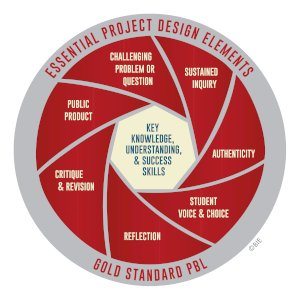 BIE defines project-based learning as “a teaching method in which students gain knowledge and skills by working for an extended period of time to investigate and respond to an authentic, engaging and complex question, problem, or challenge” (Buck Institute for Education, 2017).
BIE defines project-based learning as “a teaching method in which students gain knowledge and skills by working for an extended period of time to investigate and respond to an authentic, engaging and complex question, problem, or challenge” (Buck Institute for Education, 2017).
In order to deliver a powerful inquiry-based program that increases student-autonomy and collaboration at every stage of the Discovery Projects, aspects of the Question Formulation Technique (QFT) as used by the Right Question Institute (RQI) are also incorporated:
- Ask as many questions as you can
- Do not stop to discuss, judge or answer the questions
- Write down every question exactly as stated
- Change any statement into a question
By focussing on questions as the driver of curiosity and learning, it is understood that students will take ownership of their Discovery Projects through voice-and-choice while building links to real-world connections through their growing reflective knowledge. This ultimate inquiry method—as frustrating as it can be to those students used to learning in more traditional rote ways—also builds resilience by promoting an open mind to differing possibilities, including the possibility of failure.
Multiple-choice tests communicate nothing about school climate, student engagement, the development of citizenship skills, student social and emotional health, or critical thinking. School quality is multidimensional.
–Jack Schneider is an assistant professor of education at the College of the Holy Cross and the director of research for the Massachusetts Consortium for Innovative Education Assessment.
Teachers at RLC saw an opportunity for DISCOVERY DAYS to develop new professional skills as facilitators. As this is a whole-school initiative and incorporates up to 30% of each student’s summative marks, why not facilitate students towards combining ideas for their Discovery Projects. Cross-curricular learning at the high school level is often difficult to organize. Subject teachers rarely teach complementary units and assessment of these projects takes extra collegial meetings that rarely happen. This is unfortunate, given how important it is for students to view all knowledge areas as vital and connected.
The key aspect of DISCOVERY DAYS is the prospect of students being able to complete one or two integrated projects instead of four separate ones.
For this first round of DISCOVERY DAYS, students chose from preselected HMW questions for each of their subjects. They were then guided by facilitators to develop partially-integrated HMW questions that combined curriculum outcomes from at least two subject areas. The bold students challenged themselves to create a fully-integrated HMW question that covered all subject expectations.
Students begin to take part in defining learning goals, connecting the learning to their own interests and aspirations and becoming more active observers and guides to their own and to their peers’ learning and progress. Deep learning tasks build upon the foundation of the new learning partnerships. They challenge students to construct knowledge and begin to use their ideas in the real world. In the process, they develop key skills and the experience of doing ‘knowledge work’ in ways that develop tenacity, grit, and the proactive dispositions that pave the way to flourishing futures. (Fullan, 2014)
Facilitation in the technology age is a relatively new professional skill that deserves more opportunities and support for teachers to practice and develop in their classrooms. Project-based learning is a natural opportunity to ask deeper questions of students and share in big ideas while fostering real-world connections. As learning becomes more autonomous and adaptive, important skillsets and mindsets such as modelling, encouragement, discernment, and inspiration become vital transmission tools for new flexible learning spaces that aren’t conducive to “chalk and talk”. Facilitation differs from regular instruction and coaching in that on the surface it looks like nothing is happening. Underneath, however…
Gamifying 21st Century Skills: Part 1
Cohort21 continues to be a game-changer for me.
Mentally shifting my previous professional teaching experiences, from schools of well-intentioned colleagues, to this collaborative learning hive of like-minded ed-heads, has transformed my teaching practice in ways I have yet to truly reflect on. Except here:
I walked into the last F2F meeting with more than just a head-cold; I also had a head full of ideas and scatterbrain proposals from which to dump on this unsuspecting source of formative feedback junkies. My new role as Academic Lead at Rosseau Lake College has awarded me the freedom to develop areas of interest that “might” just indeed help our school move forward. Of course, almost instantaneously, the dreaded symbolic starting block reared it’s cosmetically challenged head, in oversized, day-glo sky-writing: Where do I begin?
LEVEL 1: THE WHERE
Luckily, our esteemed facilitators (@jmedved & @gnichols) and coaches at Cohort21, are well-versed in the language of stumble, and had problem-solving solutions waiting in the wings (literally, the wings of the York School hallways, used brilliantly as limbic nerve-system galleries of crowd-sourcing). The Design Thinking worksheets, sticky-note brainstorms and timed exercises, provided by @lmcbeth and Future Design School, were also a wonderfully scaffolded entry point into generative thinking, well away from the usual Saturday PD day-dreaming and doodle sessions of my past.
My original intention was to use the Cohort community as supercharged leverage for reimagining and rebooting our Master Schedule— a commitment to change which RLC (Roseau Lake College) is currently highly invested in. The unique process of design-thinking around this challenge, we began as a school last spring; with typical brainstorming results benefiting most from a speculative standpoint, with the not unusual— sometimes confusing and muddling— side effect of losing some staff through endless permutations of opportunity and critique. Ultimately, I concluded, that, as a school, we were already well ahead in unpacking this sticky-note problem— already at the prototyping phase, really (exciting stuff, TBA!)— and this being too specific a challenge, to be used as my Cohort21 action research springboard.
So, as a poet of pedagogy, as an agent of change, an adjunct adaptor of assessment, and as I am wont to do, I revised my original plan. Not changed tactics so much as I lessened the scope of my (ego)concentric circle to focus on another of my whole-school pet passion projects/peeves: 21st Century Skill Development.
1. Essential Skills from Most Likely to Succeed on Vimeo.
LEVEL 2: THE WHY
I’m certainly not the first teacher to notice the writing on the pedagogical wall; the recent paradigm shift in teaching and learning, away from content and towards competencies, has been slowly evolving over the past decade or more (http://www.p21.org/our-work/resources/for-educators#SkillsMaps). The internet is a far better provider of knowledge than any one teacher could ever hope to be. One only need look at the proliferate example of Khan Academy, how its open-source adaptive technology has enabled a whole new generation of students to effectively tech-learn numeric knowledge in a scaffolded way, previously only possible through linear textbook instruction (Khan has naturally set their sites on literacy and grammar as well: https://www.khanacademy.org/humanities/grammar)
This evolution is a great relief to me, I’ve never been interested in any aspect of teaching that has me churning out cookie-cutter lessons or exacting standardized assessments like a machine; unfortunately, this delicate transition has been an obstacle to some teachers who have, perhaps unconsciously, staked, not only their professional claim, but also their identity around a proven silo of knowledge and/or singular interpretation of curriculum (especially at the secondary school level). I say, let the robots take over all the deductive aspects of school and learning! The computer has already made obsolescence a fact of life in other disciplines such as banking, manufacturing, health, military— why not education? If we, as educators, want to not only stay relevant, but also stay employed in the 21st century, we need to use content to teach skills. We need to become critical and creative facilitators of deeper learning skills and life skills. We need to become Poets of Pedagogy!
LEVEL 3: THE WHAT
After much reflecting and validating (… the Discovery Process…) on a possible teaching problem, and through the integral help of a feedback partner (@vboomgaardt), I finally widdled-down my “mighty” action research question:
How might we gamify 21st century skill development, so students can track their own learning, and teachers can gain meaningful evidence for feedback and reporting?
In order to arrive at this question, I first had to empathize with TWO END USERS in my design problem: both students and teachers. TWO END USERS!?! I think that’s okay, isn’t it? Yes, I think that’s just fine. The students will, of course, be the benefactors of a more streamlined, transparent, credential-focussed, success-driven criteria program around 21st century skill development. The teachers, as well, will need to be able to adapt these competencies and rubrics into their curriculum in ways that deepen and heighten curriculum expectations. If, along the way, we can get all edtech and add an app somewhere in the mix, well, hell, as my grandmother used to say, we’re cookin’ with gas!
Throughout this iterative process, I asked around the cohort to see if other CIS schools had identified “soft skills” as a potential problem worth solving. Similar questions around competencies did indeed exist, however, the conclusion I came to was although every school reported on work habits and had even made inroads into critical and creative thinking, there didn’t seem to be a whole-school system out there for assessing competencies in an intrinsic or adaptive way. It seems to very much still be at the mercy of individual teachers, which doesn’t really signal to the students or parents the importance of this shift in education. One of the simple questions I asked my fellow teachers was this: “What is the difference between a Grade 7 collaboration and a Grade 12 collaboration when it comes to assessing work habits?”. No one was able to give me an answer with any authority or consistency. With this Action Plan, I am to change that.
LEVEL 4: THE HOW
“Curious kids learn how to learn, and how to enjoy it – and that, more than any specific body of knowledge, is what they will need to have in the future. The world is changing so rapidly that by the time a student graduates from university, everything he or she learned may already be headed toward obsolescence. The main thing that students need to know is not what to think but how to think in order to face new challenges and solve new problems.” (p.14)
This is from Amanda Lang’s, The Power of Why. I haven’t read her book, and I probably won’t have time, sadly. Nevertheless, this quote, taken from a MindShift blog about skills education (https://ww2.kqed.org/mindshift/2013/11/14/why-academic-teaching-doesnt-help-kids-excel-in-life/), resonated with my predicament.
When I arrived at Rosseau Lake College last year, they had already started a transition into a new strategic plan (Future Forward) which I am lucky to help continue to shape this year. One of the hallmarks of this plan is a personalized approach to education, using what we call a PLP (Personalized Learning Profile). Partnering with the learning and development company, LIKA (http://www.lika.ca/home2/), our students are able to approximate their learning preference through a multiple-intelligence, psychometric online test. Simply, this allows each student and teacher to see individual learning strengths and weaknesses as a visual quadrant infographic.
In addition to the PLP, LIKA has recently developed a list of 7 Skills which have already been Ministry approved and will form the foundation of RLC’s 21st Century Competencies.
These skills will be the basis for my Action Plan:
- Self-Management
- Teamwork
- Thinking
- Networking and Communication
- Information Management
- Learning
- Design and Innovation
Finally, through the crowd-sourcing inspiration stage of our last F2F, I received a heap of ideas, many of them game and tech-related, to help me on my quest.
LEVEL 5: THE WHEN
It’s all happening in Semester 2. I am lucky to have both Junior and Senior Division Curriculum leads to help co-construct criteria around these skills. There is much research to conduct around badge creation, interactive motivator apps, Google Suite apps, JoeZoo, Doc Appender, and LMS systems. As well, I will be interviewing both of my END USERS throughout the process for feedback and suggestions.
A huge thanks to @ddoucet, @shelleythomas, @jsmith, @brenthurley, @jweening, @egelleny, @timrollwagen, and others I may have failed to mention, for their continued assistance, guidance, and encouragement.
To be continued in PART 2.
Multidisciplinary Thinking Begins by Looking at Yourself
One of the most common criticisms from high-school teachers, around the topic of cross-curricular implementation, is how hard it is to schedule. Everyone loves the idea of multidisciplinary activities, but other than actual interdisciplinary courses (IDC)— where two or three subjects are mandated to mix and mingle— few schools can boast of regularly achieving this gold standard of 21st century knowledge integration.
Instead of spending last summer trolling ministry websites or updating persistently nagging AQ credentials, or even skimming chapters of the latest guru on innovation and personal branding, I did what I assume most teachers need to do on their off time— I vegged out. Now, becoming a vegetable on my vacation did not mean I stopped thinking about pedagogical approaches to curriculum design, no, no, no (I am, like most lifers, a 24/7 teacher). Far from it. I did what millions of teachers do best– I turned a television show into a future lesson plan!
The show is Netflix’s superb documentary, “Chef’s Table”, which, if you haven’t already had a chance to watch, is an absolute delight of the senses and the spirit. The episode that stood out for me, and got my pedagogical flavours flowing, was the first of Season Two, with the esteemed American chef, Grant Ashatz, showcasing his experimental art project/restaurant, Alinea.
What makes the food that we do at Alinea so interesting on the outside is that we really don’t let ourselves say no to an idea.
What struck me immediately about his imaginative approach to cuisine, was how similar it was to lesson planning. He always starts with a question: In his case, “why do patrons have to eat on plates?”; in my case, “why do multidisciplinary activities have to involve other classes?”
In designing an ISU for last year’s Grade 12 English class, I wanted to encourage a personalized and multidisciplinary approach by providing choice over what topic of English they wished to involve in their project. Through much discussion and co-construction (and some critical processing of my own) we came to the realization that there were at least 4 major subjects within English (Science, Sociology, Art, and Philosophy). Anyone who has taught Theory of Knowledge in an IB setting should recognize the similar pattern here. What was important to me was the senior students themselves came to this vital conclusion— that all subjects have other subjects within them, that the concept of “subject” is just a label, a way to organize information. From there the “buy-in” was easy, as most students were able to find a comfortable entry point into their project, based on a subject they enjoyed more than English, or were more skilled at. I also encouraged each student to talk to a teacher from the subject area they chose, to further deepen their research. No major rescheduling was necessary.
Grant Ashatz set the culinary world alight by challenging the basic assumptions of fine dining. He saw the simple ritual of eating to be full of potential for awe inspiring moments. Asking yourself the hard, reflective questions regarding your own practice, especially around subject stereotypes, is precisely the path towards innovation all teachers can use to reinvigorate their practice, and all students are waiting to ask. Why do we use textbooks in math? Do English students have to read the entire text? Does learning need to take place inside? Why do we need grades? Would this topic be best learned online? Do I have to write this down, can’t I just tell you?
Sometimes thinking outside the box means gaining inspiration from disciplines other than your own, other than education. Challenge the status quo. Give yourself permission to fail. Set limits to increase your creativity. These are not article links off Edutopia, they are lessons I learned from binge watching Netflix!

